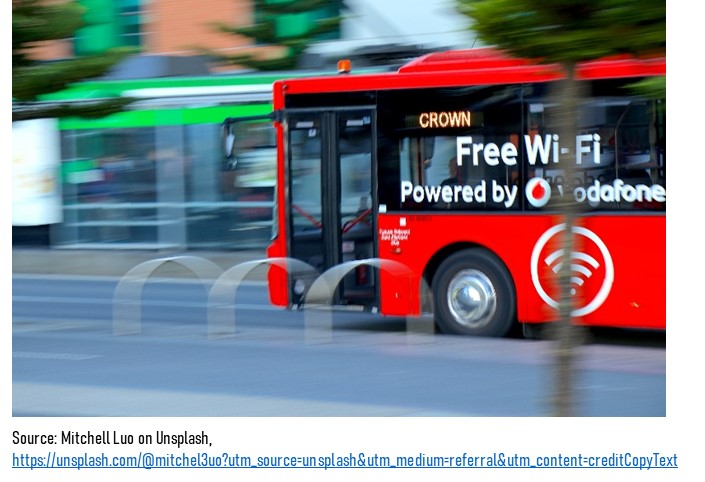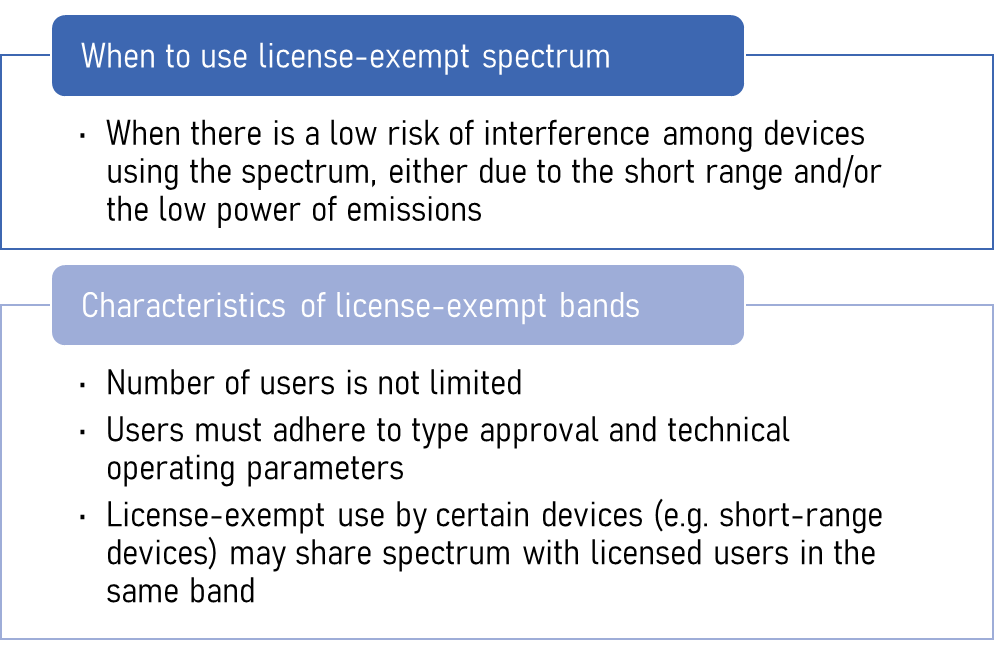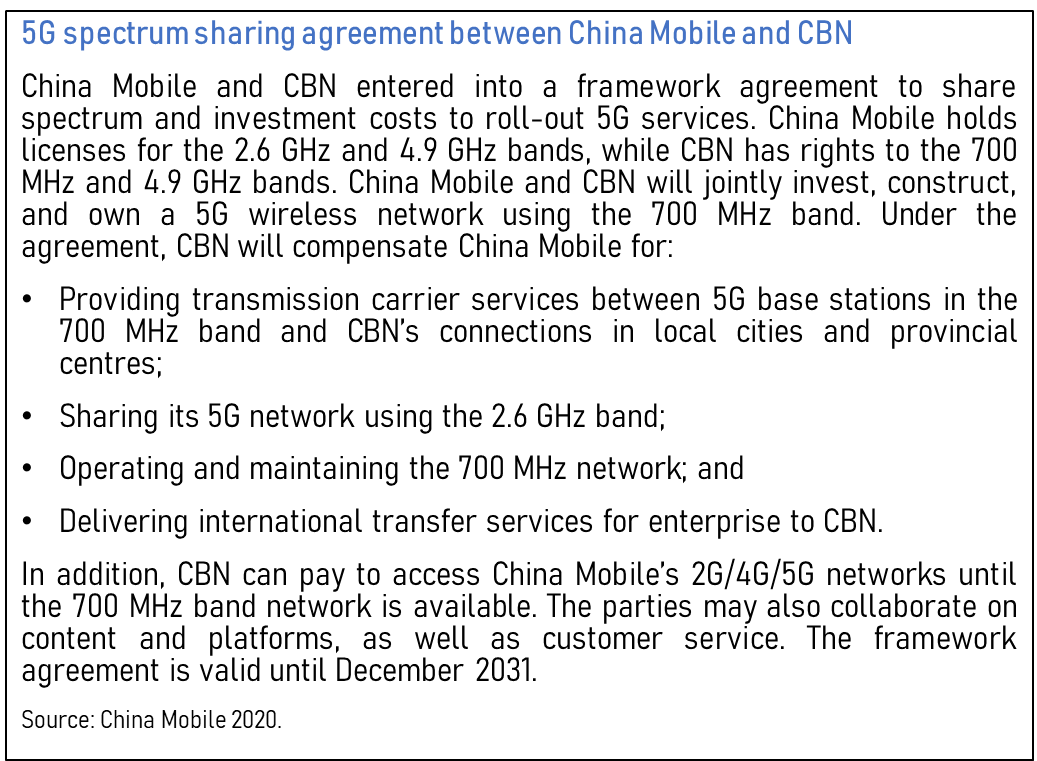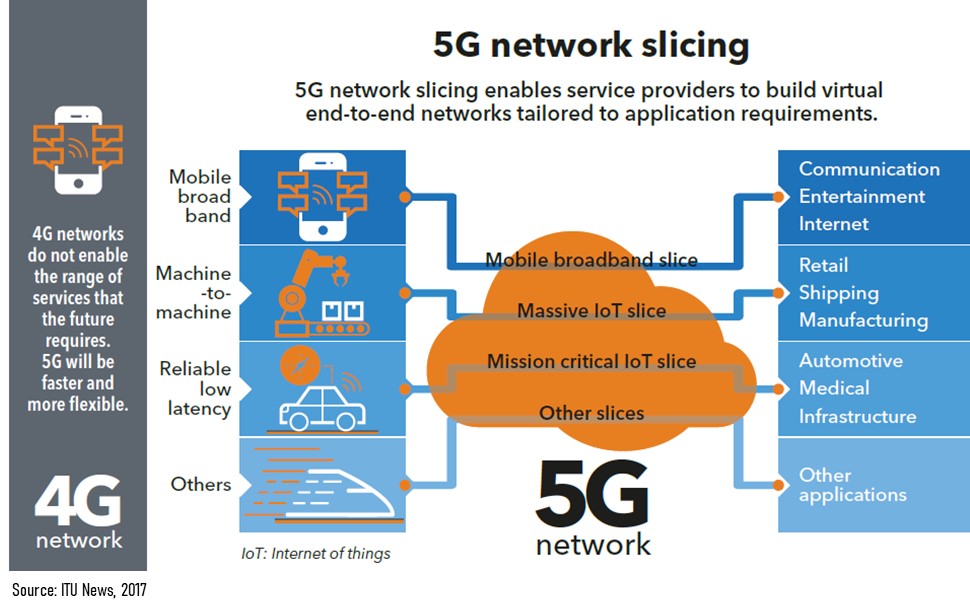Use of shared spectrum at the national level
25.04.2025Types of spectrum sharing licensing regimes
Shared access regimes are one way for regulators to open spectrum to more users and to facilitate the use of spectrum bands, especially when an exclusive use is not possible in the short term. Spectrum sharing can either be part of a licensed or unlicensed regime. Under shared access regimes, use is authorized by a license for a set of different types of services or between users, under conditions defined in the license to avoid harmful interference. Under an unlicensed or license-exempt regime, no license is required, and the number of users is not limited by the regulator. However, users must adhere to technical restrictions (e.g., power limits for receivers and transmitters, maximum levels of out-of-band emissions, etc.) and existing regulations.
Shared access
Shared access arrangements can help regulators strike a balance between making the most amount of spectrum available while safeguarding access to spectrum for incumbent radiocommunication services. This approach can foster spectrum efficiency by leveraging spectrum that may be underused by providing access when spectrum cannot be released in all areas or within a reasonable time. Regulators usually adopt a licensed access approach when spectrum use must be managed to mitigate unwanted interference, which can be done through dynamic or static coordination approaches.
The establishment of share access frameworks requires the definition of the prioritization of users in the proposed band and conditions that each user tier can expect for access to the spectrum. Furthermore, the terms and technical operating conditions that will manage interference between different users, and a mitigation plan in case of unwanted interference should be defined. Several regulators have licensed access sharing regimes in place, including among others:
- The shared access framework established in the United States for the 3.5 GHz band – called the Citizens Broadband Radio Service – dynamically manages spectrum use between incumbent users, priority access licensees, and general authorized access users through a spectrum access system (SAS). Incumbent users are most protected against harmful interference, whereas general users receive no protection from other users. The SAS assigns spectrum to users dynamically, according to the users’ priority and current use in a geographic area. This manages spectrum use dynamically between incumbent federal and non-federal users of the band and citizens broadband radio service (CBRS), to accommodate various uses, including the fifth generation (5G) and the Internet of Things (IoT) applications (USA, FCC 2023).
- The United Kingdom established a Shared Access License, which is available for the 1 800 MHz (1 781.7-1 785 MHz/1 876.7-1 880 MHz), 2.3 GHz (2 390-2 400 MHz), 3.8-4.2 GHz, and 24.25-26.5 GHz bands. There are two types of licenses available, either low- or medium-power licenses that define use according to technical operating parameters. The two types of licenses can be used for all the bands, except for the 24.25-26.5 GHz band, which is only valid for indoor low-power use. The four shared access bands have various potential uses, including for private networks, mobile rural or indoor coverage, or fixed wireless access. The licenses have unlimited validity, as long as the annual license fees are paid and the terms and conditions of the license are upheld. The regulator assesses applications for shared use of the spectrum to ensure non-interference with existing licensees and grants licenses on a first-come, first-served basis (UK, Ofcom 2019a). The regulator has continued to assess the sharing framework’s success and recently conducted a consultation to liberalize rules to support new use cases, add additional spectrum, reduce separation distances between users, and improve the application process, with updates approved in July 2024 (UK, Ofcom 2024).
- The United Kingdom also established a Local Access License, which provides access to unused mobile spectrum. The license grants access to mobile spectrum that is unused in certain geographic areas, upon agreement with existing licensees that the new user is unlikely to cause interference or constrain plans. The license will specify the location and terms of access to avoid interference with the incumbent operator and will have a validity of up to three years. The license cannot be renewed; a new application would have to be filed. Given that unused spectrum is likely to be in less-populated areas, the regulator expects these local access licenses to support wireless broadband services or local private networks. While spectrum trading and leasing are possible under existing mobile spectrum rules, it has been used most often to transfer rather than share spectrum rights (UK, Ofcom 2019b).
- Hong Kong, China designated 400 MHz of spectrum in the 26/28 GHz (27.95-28.35 GHz) bands to be available for licensed shared access, in blocks of 100 MHz. In addition to the 400 MHz set aside for shared spectrum, the Office of the Communications Authority (OFCA) assigned 400 MHz each to three mobile operators on an exclusive, non-shared basis. The licenses will be for “localized wireless broadband service” and permit non-exclusive use of spectrum in a defined area of no more than 50 square kilometres. Since the use is tied to a geographic area, the same frequency channel can be reused in different areas around the region. Licenses will be issued initially for five years, with the possibility for renewal for an additional five years (Hong Kong, China, OFCA 2021).
- China assigned licenses to China Telecom Group, China United Network Communications Group (China Unicom), and China Radio and Television Network (also known as China Broadcasting Network), authorizing the shared use of the 3 300-3 400 MHz band. The spectrum is awarded on a shared basis to promote the co-investment and sharing of infrastructure. Interference is mitigated through nationwide, indoor-only use. This marks the first time the Ministry of Industry and Information Technology (MIIT) has taken such a shared approach (China, MIIT 2020).
However, mobile operators have pointed out that licensed shared access to spectrum should not be considered a replacement for exclusive nationwide access to mobile spectrum. While shared spectrum may be a complement, operators stress the need for exclusive spectrum to meet quality of service and coverage standards and to provide investment certainty in network deployments (GSMA 2021). Also, while the above examples show how regulators have set frameworks to encourage spectrum sharing, existing spectrum frameworks often allow users to enter into spectrum sharing agreements voluntarily when spectrum is not being used. This is the same concept as described in the LSA model but, in this case, operators can do so voluntarily under defined compensation terms.
License-exempt access

License-exempt bands provide access to spectrum without a heavy regulatory burden nor restriction on the number of users. This licensing category grants non-exclusive use of spectrum upon adherence to certain operating parameters. Since spectrum in these bands is shared, it is especially important that users maintain emissions within the permitted range and that the equipment being used adheres to type approval requirements and strictly comply with regulations in force.
Users of this type of spectrum are sometimes required to register with the regulator and pay a nominal fee but often use is unrestricted as long as users adhere to specifications tied to the spectrum use. This is sometimes referred to as unlicensed spectrum and may also be called a class license, especially if some sort of registration is required. For instance, the Netherlands permits the use of certain frequencies bands by Bluetooth, Wi-Fi, contactless payment, remote controls for car locks, and other types of equipment characterized by a low transmission power, without a license or notification to the regulator before use (Netherlands, Agentschap Telecom 2015). Other types do require notification in the Netherlands, such as maritime mobile communication and amateur radio equipment (Netherlands, Ministry of Economic Affairs and Climate 2016, pp. 29-30). Those which do require notification usually must do so regularly (e.g., annually).

The lower regulatory burden of these bands has made them a breeding ground for innovation. Several applications operate in license-exempt bands, including Bluetooth, Wi-Fi, radiofrequency identification (RFID), industrial, scientific, and medical (ISM) equipment, and other short-range devices. These bands are expected to continue be used in the future. Unlicensed bands may also be of interest of mobile broadband networks, including in 5G deployments. Together with licensed spectrum, license-exempt spectrum can provide additional capacity and increased bandwidths.
Some administrations recognized the potential of unlicensed spectrum and are considering the use of additional bands on a license-exempt basis. The United States released the 6 GHz spectrum and several bands above 100 GHz for license-exempt use (USA, FCC 2020b; USA, FCC 2019). The FCC opened 21.2 GHz of spectrum in the 116-123 GHz, 174.8-182 GHz, 185-190 GHz, and 244-246 GHz bands on a license-exempt basis, under specific technical parameters. Other countries have since adopted similar regulations to allow license-exempt use in portions (or the entirety) of the 6 GHz band, including Bahrain, El Salvador, Kenya, Greece, and Thailand, among others (Wi-Fi Alliance 2024).
Regulators should continue to value license-exempt spectrum and consider the possibilities of releasing additional spectrum on a license-exempt basis in certain bands to support future applications. Regulators should conduct due diligence to ensure coexistence with other users and establish clear guidelines and operating parameters for unlicensed use to avoid harmful interference and strict compliance with the national and international radio regulations.
Market implementations of spectrum sharing
Active infrastructure RAN sharing
An increasing number of mobile network operators are teaming up with competitors to share infrastructure and investment costs. This evolved out of a need to densify networks in urban centers and also fulfil coverage obligations in less populated areas. While widely implemented for 3G and 4G networks, infrastructure sharing is especially important to reduce the costs of 5G network deployments. Cooperation is more commonly focused on passive infrastructure, like masts, towers, and sites, although some agreements include sharing active infrastructure, such as transmitter, and antennas.
Radio access network (RAN) agreements define the terms that operators obtain to share networks, which include active elements of RAN in some cases, like spectrum resources. Mobile operators in Denmark, Finland, France, Poland, and Sweden have undertaken sharing agreements that include spectrum, under defined terms that specify the geographic area of sharing and/or the timeframe of the sharing agreement (BEREC 2018, pp. 10-11). In May 2020, China Mobile Communications Group Ltd. (China Mobile) and China Broadcasting Network Corporation Ltd. (CBN) signed a framework agreement to share spectrum to facilitate 5G deployment and coverage (China Mobile 2020). In another example, in Australia, Optus and TPG Telecom entered into a network-sharing agreement to enhance 5G coverage, particularly in regional areas, aiming to improve service quality and competitiveness (Opus 2024).

Such sharing arrangements allow operators to split the burden of network investment and to accelerate the time needed to deploy national networks. Many regulators are in favour of actions that encourage network deployment and investment, which aligns with the goals of the spectrum sharing models.
However, this model does have potential risks to competition, depending on many variables, including the conditions of the sharing agreements, the extent of the joint activities, and the competitiveness of the market. Regulators oversee such agreements to mitigate these risks and uphold market competition. For instance, spectrum sharing could be allowed only for a specific period or in certain areas, or until sufficient spectrum is released. Such measures would avoid only one national network being deployed in a specific area, encourage network redundancy, and protect competition. Other regulatory measures could be put in place to prevent the parties from acting like a merged entity, gaining market dominance in the market, or decreasing competition in the wholesale or retail markets. Regulators should consider allowing active infrastructure sharing to encourage a quicker deployment of networks and a shared burden of investment among operators, while also putting in place safeguards to protect competition.
New ways operators are using spectrum: network slicing and dynamic spectrum sharing
One of the aims of spectrum sharing is to promote more efficient spectrum use. Network slicing and dynamic spectrum sharing (DSS) are two technological innovations that are helping operators to use spectrum more efficiently in their networks. Network slicing is a form of network virtualization made possible through software-defined networks and network function virtualization. It allows several service networks, or slices, to be served with the same physical infrastructure (OECD 2022, pp. 27-28). This enables operators to provide different types of services per network slice, tailored to the necessary service characteristics such as latency, speed, security, or reliability.

As mobile operators transition from 4G to 5G networks, network slicing can help them to efficiently use spectrum to meet their needs as more data-heavy 5G applications begin to be supported. However, network slicing is expected to be particularly impactful once 5G networks have been fully rolled out, when different 5G usage scenarios take root, and it can be applied at a large scale.

Dynamic spectrum sharing has also been discussed as a possible solution to use mobile spectrum more efficiently as operators transition from 4G to 5G networks. DSS allows operators to use existing 4G spectrum to provide 5G service through a software upgrade. It uses existing infrastructure, facilitating the transition from a 4G network, to a non-standalone 5G network, to finally a standalone 5G network (Ericsson, no date). With DSS, an operator can dynamically assign spectrum to 4G and 5G, depending on the traffic to the cell. Since the updates can be made over software, DSS may ease the financial burden as existing hardware and sites can be reused (as long as they are 5G-compatible) and decrease the time to upgrade the network.
Another form of dynamic spectrum sharing is automated frequency coordination (AFC), which is used to manage unlicensed spectrum use in the 6 GHz band. AFC systems utilize licensing information from regulators to determine exclusion zones and permit unlicensed access to bands at frequencies and locations with existing incumbent users (OECD 2022b). In Australia, regulators are considering implementing AFC – as has been done in the United States, Canada, and Saudi Arabia – to enable additional unlicensed use in the upper portion of the 6 GHz band (Australia, ACMA 2024).
Key findings
Use of shared spectrum at the national level
|
References
Australia. Australian Communications and Media Authority (ACMA). 2024. “Future use of the upper 6 GHz band. Options paper. https://www.acma.gov.au/sites/default/files/2024-06/future_use_of_the_upper_6_ghz_band_options_paper.pdf.
Body of European Regulators for Electronic Communications (BEREC). 2018. BEREC Report on infrastructure sharing. https://berec.europa.eu/eng/document_register/subject_matter/berec/download/0/8164-berec-report-on-infrastructure-sharing_0.pdf.
China. Ministry of Industry and Information Technology (MIIT). 2020. The Ministry of Industry and Information technology permits China Telecom, China Unicom, and China Radio and Television to jointly use the indoor frequency of the 5G system. [Press release]. February 10. http://www.miit.gov.cn/n1146290/n1146402/c7671201/content.html.
China Mobile Ltd. 2020. [Press release]. “Collaborative framework agreement in relation to 5G co-construction and sharing entered into between parent company and China Broadcasting Network Corporation Ltd.” https://www.chinamobileltd.com/en/file/view.php?id=230559.
Ericsson. “Ericsson Spectrum Sharing – A better way to build 5G.” https://www.ericsson.com/en/networks/offerings/5g/sharing-spectrum-with-ericsson-spectrum-sharing.
GSMA, 2019. Spectrum Sharing: GSMA Public Policy Position. https://www.gsma.com/spectrum/wp-content/uploads/2019/09/Spectrum-Sharing-PPP.pdf.
Hong Kong, China. Office of the Communications Authority (OFCA). 2019. “Guidelines for submission of applications for assignment of shared spectrum in the 26 GHz and 28 GHz bands under the Localised Wireless Broadband Service License”. https://www.coms-auth.hk/filemanager/statement/en/upload/575/gn172021.pdf
International Telecommunication Union News (ITU). 2017. “Why end-to-end network slicing will be important for 5G”. https://news.itu.int/why-end-to-end-network-slicing-will-be-important-for-5g/.
Opus. 2024. “TPG Telecom and Optus sign network sharing agreement marking new era of mobile services for regional Australia.” Press Release. April 24, 2024. https://www.optus.com.au/about/media-centre/media-releases/2024/04/tpg-telecom-and-optus-sign-network-sharing-agreement.
Organisation of Economic Cooperation and Development (OECD). 2022. “Broadband Networks of the Future”. OECD Digital Economy Papers, No. 327. Paris, France : OECD. https://www.oecd.org/content/dam/oecd/en/publications/reports/2022/07/broadband-networks-of-the-future_cb6dd626/755e2d0c-en.pdf.
Organisation of Economic Cooperation and Development (OECD). 2022. “Developments in Spectrum Management for Communication Services”. OECD Digital Economy Papers, No. 332. Paris, France : OECD. https://www.oecd.org/content/dam/oecd/en/publications/reports/2022/10/developments-in-spectrum-management-for-communication-services_ae18e03f/175e7ce5-en.pdf (b).
Qualcomm. 2017. “3GPP starts study on 5G NR spectrum sharing”. [Press release]. April 26. https://www.qualcomm.com/news/onq/2017/04/26/3gpp-starts-study-5g-nr-spectrum-sharing.
Regulation on the use of frequency space without license and without notification obligation 2015. [Regeling gebruik van frequentieruimte zonder vergunning en zonder meldingsplicht 2015]. The Netherlands. https://wetten.overheid.nl/BWBR0036378/2016-12-28#Bijlagen
Resolution 21/2019. [Resolución 21/2019]. Argentina. https://www.boletinoficial.gob.ar/detalleAviso/primera/221017/20191111.
The Netherlands. Agentschap Telecom. “Frequency Use without a license”. https://www.agentschaptelecom.nl/onderwerpen/vergunningvrij-frequentiegebruik.
The Netherlands. Ministry of Economic Affairs and Climate. 2016. Radio Spectrum Policy Memorandum. https://www.government.nl/binaries/government/documents/reports/2017/03/07/radio-spectrum-policy-memorandum- 2016/Netherlands_Radio_Spectrum_Policy_Memorandum_2016.pdf.
United Kingdom (UK). Office of Communications (Ofcom). 2020. “Improving spectrum access for Wi-Fi: spectrum use in the 5 and 6 GHz bands.” https://www.ofcom.org.uk/__data/assets/pdf_file/0038/189848/consultation-spectrum-access-wifi.pdf. (a)
United Kingdom (UK). Office of Communications (Ofcom). 2020. “Further consultation: Supporting innovation in the 100-200 GHz range.” https://www.ofcom.org.uk/consultations-and-statements/category-2/supporting-innovation-100-200-ghz. (b)
United Kingdom (UK). Office of Communications (Ofcom). 2019. “Enabling wireless innovation through local licensing: Shared Access to spectrum supporting mobile technology”. https://www.ofcom.org.uk/__data/assets/pdf_file/0033/157884/enabling-wireless-innovation-through-local-licensing.pdf. (a)
United Kingdom (UK). Office of Communications (Ofcom). 2019. “Local Access License”. https://www.ofcom.org.uk/__data/assets/pdf_file/0037/157888/local-access-licence-guidance.pdf. (b)
United Kingdom (UK). Office of Communications (Ofcom). 2024. “Statement and further consultation: Supporting increased use of shared spectrum”. https://www.ofcom.org.uk/spectrum/frequencies/consultation-supporting-increased-use-of-shared-spectrum/
United States of America (USA). Federal Communications Commission (FCC). 2020. “Unlicensed Use of the 6 GHz band”. https://docs.fcc.gov/public/attachments/DOC-363490A1.pdf. (b)
United States of America (USA). Federal Communications Commission (FCC). 2019. “FCC Opens spectrum horizons for new services and technologies”. https://www.fcc.gov/document/fcc-opens-spectrum-horizons-new-services-technologies-0.
United States of America (USA). Federal Communications Commission (FCC). 2023. “3.5 GHz Band Overview”. https://www.fcc.gov/wireless/bureau-divisions/mobility-division/35-ghz-band/35-ghz-band-overview.
Wi-Fi Alliance. 2024. “Regulations Enabling 6 GHz Wi-Fi”. Austin, Texas, United States. https://www.wi-fi.org/regulations-enabling-6-ghz-wi-fi.
Last updated on: 28.04.2025